62 Salsa and Afro-Cuban rituality
Salsa is a generic name to refer to the mixture of Afro-Cuban music, Caribbean music, Rumba and Latin jazz. Salsa significa “sauce,” porque la salsa es una mezcla=mixture de ingredientes. Likewise, salsa music is a mixture of genres. Los cubanos que migraron a New York y los artistas boricuas introducen estilos de Latin Jazz, and that’s “salsa” music. Todo esto ocurrió entre los 1950s and the 1960s.
Un tema importante de la salsa es la práctica religiosa derivada de la santería y la religión yoruba. En otras palabras, the prayer uses the nature forces to bring the favor of the God. La religion voodoo de New Orleans tiene un origen similar porque los slaves vienen del África occidental. Africans from Cuba arrived from closeby regions in Africa than those of New Orleans. So similarities are not a coincidence.
The Afro-Cuban religion or “Yoruba” also gives name to the language. Original salsa often uses Spanish and yoruba languages Africans in Cuba had secret societies in honor to their deidades. Dioses y diosas yorubas se llaman “orishas.” Ritual music made to honor orishas later became “salsa”.
The batá music is the original ritual music of Afro-Cuban secret societies that existed during the 19th century to honor their African orishas. This music is mainly accompanied by a diversity of drums and voice.
“Canto a Eleggua” uploaded by Caracoles de Elegguá
Music was believed to have the potential to invoke the orishas that came into the shaman and inspired ecstatic movements. Salsa movements originate in the idea of orishas coming to guide your body, especially Changó, the God of drums.
Here are some examples of orishas:
- Babalú ayé: Orisha of illness and health
- Obatalá: Orisha of wisdom and peace
- Changó: Orisha of masculinity, drums, and thunder
- Yemanyá: Orisha of feminity
- Oggun: Orisha of war, locksmiths, military, and police

Santería is other name to the Afro-Cuban religions. To avoid punishment from the Catholic church, Afro-Cubans used Catholic saints to honor their orishas. Santería is the usage of saint imaginery to honor African orishas.
Babalú Ayé es San Lázaro:

Changó es Santa Bárbara:
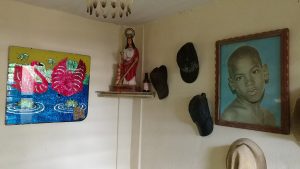
Babalú Ayé, orisha of illness
In santería, the god of illness is Babalú Ayé which in santería is honored as San Lázaro. The Cuban dueto Celina y Reutilo during the 1940’s and 1950’s sang to Babalú Ayé en la canción San Lázaro (1956):
San Lazaro – Celina y Reutilo
Richie Ray was a boricua born in New York, and joined Bobby Cruz to start making Cuban music with some Latin Jazz elements in the 1960’s. Despite being Puerto Ricans, they honor the Afro-Cuban gods perhaps as a way to express their identity to the Caribbean. Santería and salsa became a symbol of Caribbean identity. The name “Richie” is a nickname for the Spanish name “Ricardo”. That’s why he’s called Ricardo in this music.
The next song is salsa in honor to Babalú Ayé, the dios (=God) of human health and illness. He belongs to a type of devotion that involves a deep knowledge of the theology on Babalú Ayé and his properties, his story, his likes and dislikes… The name of that devotion is “Arará”, which is also a region in Africa.
“Babalú Ayé” by Richie Ray. Uploaded by lucabery.
The song starts with the voice of Babalú probably possessing the body of a shaman. Babalú starts using verbs in the present indicative to express his identity and his power:
Yo soy Babalú, camino Arará
I am Babalú (African God), the rule of Arará
y con mi trabajo la tierra tembl(ar)á (X2)
And with my job the land will tremble
In the voice of Babalú:
- yo soy Babalú=I am Babalú
- yo soy quién te está cuidando=I am who is taking care of you, from cuidar=to take care, to watch over like babysitter
- yo sé quién te está tirando=I know who is throwing you, meaning who is attacking you with magic
- yo sé quién te está velando=I know who is candling you, meaning who is lighting candles to make witchcraft against you
- yo suelto mi perro=I release my dog, like San Lázaro who is with two dogs, where SUELTO is from soltar O to UE (stem changing verb).
- me pongo mi capa=I put myself my cap, probably as a magician, from poner a YO-GO verb
- cojo mi muleta=I take my crutch, like San Lázaro who wears a crutch, but the verb is coger=to take OR to pick. It changes to J to keep the /h/ sound
- camino pa llá=camino para allá=I walk to there, resembling San Lázaro who is depicted always on a walk
Entonces el feligrés (=religious follower) responde:
Llamo a Babalú
I-call to Balalú
él viene pa(=para) acá sounds /pa ká/
He comes towards here
Babalú conmigo anda
Babalú with me walks
El cantante dice: ay que yo traigo saoco=ah that I I bring saúco, where saoco is an old form for saúco or the elderberry herb. It is used to make a magic wand and for other magic purposes. It’s also referred to the mojo necessary to dance and play well. Check my blog about saoco for this and more words totally written in Spanish:
https://bloglenguaencolombia.blogspot.com/2022/01/saoco.html
Direction expressions:
- Pa cá=para acá=to here, or towards the direction of the feligrés
- Pa llá=para allá=to there, in the voice of Babalú Ayé who goes to the direction of the feligrés
La magia is like the fight among energies. It feels as if one magician was throwing magic to the other, while the other responds with an invokation to Babalú to repel the attack. When you are being attacked by another magician, probably they have an object depicting you with candles (velas) around it.
Acciones de brujería:
- Tirar fluídos=to throw fluids against the other person. Significa usar fluidos humanos para hacer brujería: menstruación o semen generalmente. Yemanyá ama los fluidos humanos.
- Velar=to light candles on someone. Te están velando is a warning that someone is lighting candles of you to send you bad magic.
- Traer saoco=to bring the magic of an eldelberry stick against someone. It also significa la magia que necesitas para bailar. Cuando bailas bien, es Changó quien te manda esa magia.
Read in Spanish about it in Arará.
Ay, na(da) má(s)
Ay, nothing else
Yo soy Babalú, camino Arará
I am Babalú (African God), the rule of Arará
y con mi trabajo la tierra tembl(ar)á (X2)
And with my job the land will tremble
Que Babalú me dijo a mí
That Babalú said to me
yo soy quien te está cuidando
I am who is taking care of you
que Babalú me dijo a mí
That Babalú said to me
yo sé quien te está velando.
I know who is lighting candles to you (making witchcraft)
y sé quien te está tirando
and (I) know who is throwing you (attacking with witchcraft)
pero a ti no te entra na(da) /ná/
But to you enters nothing (no witchcraft affects you)
Yo siempre te estoy cuidando
I always am taking care of you
pa(ra) que no te pase na(da). (back to Yo soy Babalú)
So that nothing (wrong) happens to you.
Ay, que yo suelto mi perro
Ay that I release my dog
cojo mi muleta
take my crutch
me pongo mi capa
put (on) my cape
y camino pa(ra) allá
And (I) walk towards there
Y en cuanto yo llegue
And as soon as I arrive
todos se te irán (X2)
all will go
y pa(ra) quien lo tira (Back to Yo soy Babalú)
And to who(m) throws it (witchcraft will go back to the attacker)
Llamo a Babalú
I-call to Balalú
él viene pa(ra) acá
He comes towards here
Babalú conmigo anda
Babalú with me walks
Ay, que yo llamo a Babalú
Ay, that I call to Babalú
y él viene pa(ra) acá
And he comes towards here
porque Babalú conmigo anda (Back to Llamo a Babalú)
Because Babalú with me walks
Que tú me tiras fluidos
That you throw me (human) fluids
y te vas para atrás
And you go behind (witchcraft will go back to the attacher)
porque Babalú conmigo anda (Back to Llamo a Babalú)
Because Babalú with me walks
Ay, que yo traigo saoco
Ay, that I bring mojo
y tú lo verás
And you will see it
que Babalú conmigo anda
That Babalú conmigo anda.
Songwriters: Richie Ray, Bobby Cruz, Celina y Reutilo, my own corrected version and translation. Most lyrics transcriptions contain “a ra rá” like it was a la la la or onomatopoeia, but it’s in reality “Arará” from the rule of Arará which seems to be a region in Benín, West Africa. Also “la tierra temblá” is still mysterious to me.
Oggun
An important, but forgotten, salsa singer of the 1960’s was known as “La Lupe”. Renowned for the strong energy she put in the scenario, the rumor that she became possessed by the demon overtook her career. A calmer singer such as Celia Cruz, who was her companion in scene and production house, led the industry in the United States. La Lupe sang to San Miguel or Saint Michael, the Archangel. In Santería, Michael is the orisha Oggun. Read about Oggun.
Oggun is the brother of Elegguá, the orisha of the cross-roads, both sons of Yemanyá (=the goddess of love). Oggún protects the walkers because he resides in the mountains. He’s also protector of the smiths, soldiers, police officers and leads the wars.
Guaguancó Bembé by La Lupe
The singer starts by telling the story of her loneliness because her parents died, and how she overcame so many difficulties in her lies. However, Michael Archangel=Oggún defeated everything and provided resilience for her hard path:
San Miguel venció al enemigo y al enemigo lo venzo yo
Saint Michael defeated/won to the enemy and to the enemy him defeat I
By 1:39 she starts repeating a chant which seems to be in the Yoruba language:
bembe bembe pata pata
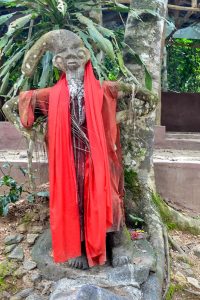
Brujería=witchcraft
Brujería or witchcraft is the way as Christians have labeled religious practices from Yoruba religions. They have even demeaned such practices as santanismo.
In the next song, entitled “Sonido bestial” (1971) by Richie Ray and Bobby Cruz, you can notice the influence of jazz in the piano parts of the song. La bestia=the beast is a reference to the devil, taking pride on the demonic label of witchcraft. When you dance inspired by Changó, your movements become crazy and ecstatic, as if some evil spirit had taken over your body. Playing the piano and drums with such magic also leads to virtuous improvs.
SONIDO BESTIAL RICARDO RAY BOBBY CRUZ
In 1:30 he says:
ahi viene Richie y viene virau (=virado) como bestia tocando un tumbau (=tumbado)
there comes Richie (Ricardo’s nickname) and comes turned/twisted as beast playing a beat
ábranle paso que viene callau (=callado) como bestia tocando un tumbau
open step (make room) that (he) is shut down (=silent) as beast playing a beat.
In Caribbean Spanish, the D often is pronounced too weak inbetween vowels, then the remaining vowels get together as a single syllable. That’s why “callado” (silent) becomes /kajáo/, then /ka-jáu/ and others in the song.
Angel Canales and Mark Dimond make a deep statement that they believe in witchcraft in the song “Yo creo en brujería”. Notice that the last name “Dimond” sounds a bit like “Demon” which is a word game referring to witchcraft:
BRUJERIA MARK DIMOND ANGEL CANALES uploaded by Luckylouie522.
La canción habla de un hombre que cree en brujería porque ama mucho a una mujer. Él la ama mucho y siente que lo tiene “amarrado” (=tied). Él repite una y otra vez: “sí, señor, yo creo en brujería” (=Yes, sir, I believe in witchcraft). Una pasión tan fuerte que solo puede ser por “la potencia africana” (=The African power). It is the power of Changó combined with that of Yemanyá because el dios de la masculinidad y la diosa de la feminidad se unen juntos para la brujería del amor. He refers to Changó again later by calling him “Santa Bárbara la santa mía”.
Later on, he mentions “San Lázaro” as someone who lifted him from the tomb: Ay Lázaro me levantó, oye, de la tumba fría= Ay Lázaro raised me, hear!, from the cold thomb. La brujería fundionó haciéndolo impotente en su energía sexual. Es decir (=That’s to say), el pene no se levanta por la brujería, y gracias a San Lázaro recobró su potencia. Parte de la brujería consiste en hacer a un hombre impotente. He uses the metaphor of a dead man as San Lázaro (=Babalú Ayé) who raised from the thomb as a miracle provided by Jesus. His penis was that dead, and now he’s alive again. The fact is that Babalú Ayé may have helped him recover their sexual drive.
He also mentions Santa Bárbara, in his mind, Babalú Ayé, which we noticed is good to repel witchcraft. Es una manera para culpar a la brujería simplemente de un sentimiento de apego=attachment sexual que tiene por una mujer. He doesn’t want to take responsibility for his feeling of attachment.
Yo creo en brujería por lo que me pasó
I believe in witchcraft for what happened to me
Tenía esta mujer que me tiene amarrado. Brujería más rabona.
I had this woman who has me tied. Witchcraft non-tailed (=stupid)
Sí, señor, yo creo en brujería. = Yes, sir, I believe in witchcraft.
Ay que la potencia es africana protejan la madre mía Sí, señor…
Ay that the power is African, protect the mother mine
Ay tayo silepa mi Changó y Yemanyá todos los días. Sí, señor…
Ay tayo silepa my Changó and Yemanyá everyday
Yo creo en brujería (….) =I believe in witchcraft Ay que la potencia…
La santa Bárbara bendita esa es la santa mía. = The Saint Barbara the Holly that’s my saint
Ay Lázaro me levantó, oye, de la tumba fría. = Ay Lázaro raised me, hear!, from the cold thomb
Songwriters: Mark Dimond. For non-commercial use only.
Folk healing
Celia Cruz was one of the main exponents of salsa music, and one of the pioneers to develop the salsa music as a genre in the New York scene. She succeed greatly during the 1960’s. She might be better known by “La vida es un carnaval”. You can hear a few seconds of this song to see if you recognize it. If not, that’s fine. This is not the song of this topic.
Celia Cruz – La vida es un carnaval by SSSOficial
El yerberito (the herbalist) is a folk healer who specializes in herbs. He brings a vast amount of knowledge on human health, but also mixes his knowledge with magic practices. She plays the voice of the herbalist by listing the herbs he brings: TRAIGO=I bring, PA=para=for, introducing the condition it heals. The choir states finally: Y con esa yerba se casa usted, and with that herb you get marry. It’s an irony the final purpose of magic is to move supernatural forces to find a good spouse. Or herbs bring the feminine spirit of Yemanyá with shared properties of fertility.
Some herbs she mentions are: The epazote (some people write it “apasote”) para los brotes (=rashes).
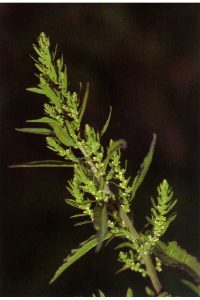
Celia menciona el caisimón pa la hinchazón (=caisimón for the swelling), which should be el caisimón de anís, some sort of herb in the anises family.
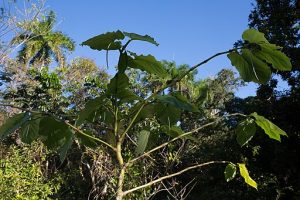
Celia menciona: yerba santa pa la garganta=yerba santa for the throath. Yerba santa is a type of mint which in tea tastes really acid, bitter, and spicy, and it’s used for respiratory illness.
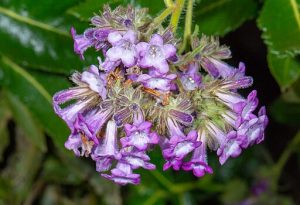
And she mentions la albahaca=basil pa la gente flaca. Ponemos albahaca fresca en la pizza, but according to Celia it works to gain weight. Even when Celia says albahaca pa la gente flaca=para la gente flaca=for skinny people, but it may be just to find something that rhymes. Remember, the H in albahaca doesn’t sound, so the two As get together. Yes, pronounce it just /albáka/.
- Verbs in the yo-form: traigo=I bring, from the infinitive traer.
- Expressions: pa which is the word para=for, when linked with “el” (=the): para el=pa el=pal=for the one
- Casarse significa to get marry. The infinitive is casar + SE (the reflexive) since one marries to each other with some one. Conjugate: me caso, te casas, se casa, nos casamos, se casan. The song has the formal usted form se casa usted.
- Yerbas: yerba santa (=a type of mint), caisimón (=anise herb), abre-caminos (I don’t know), ruda (=ruta, rue), albaca OR albahaca (=basil), epazote (=wormseed), vetiver (same in English)
- Conditions: la hinchazón pronounced /layn-cha-són/ because of the vowel linking, estornuda (=sneezes), gente flaca (=skinny people), brotes (=rashes, pimples), no ve (=doesn’t see)
Se oye el rumor de un pregonar que dice así
(It) hears the rumor of a hawking that says so:
El yerberito llegó, llegó
The (little) herbalist arrived, arrived
Traigo yerba santa pa (=para) la garganta
(I) bring saint herb (pepperleaf?) for the throat
Traigo caisimón pa (=para) la hinchazón
(I) bring anise weed for the swelling
Traigo abre-caminos pa (=para) su destino
(I) open-paths (mixture) for your destiny
Traigo la ruda pal (=para el) que estornuda
(I) bring the ruda (ruta, rue) for the (one) that sneezes
También traigo albahaca pa (=para) la gente flaca
Too (I) bring basil for skinny people
El epazote para los brotes
The wormseed for the rashes
El vetiver para el que no ve
The vetiver for the (one) that don’t see
Y con esta yerba se casa usted
And with this herb you marry
Songwriters: Nestor Milli. For non-commercial use only. The original lyrics contains “keysimón” but it’s “caisimón”, and also contains “apasote” but it’s epazote.
This is a podcast on Celia Cruz in Spanish:
